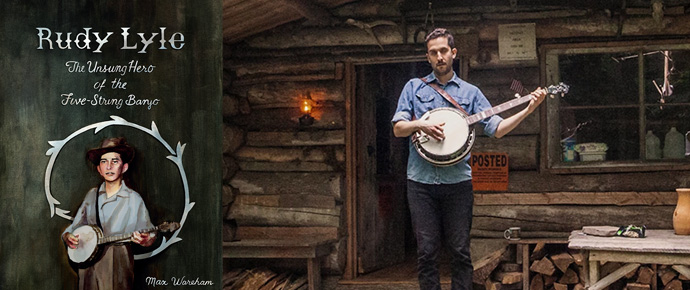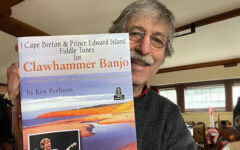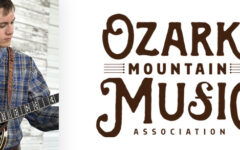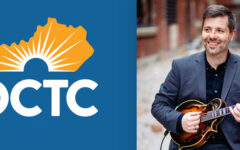
Max Wareham is a man on a mission. His new book, Rudy Lyle: The Unsung Hero of the Five-String Banjo, uncovers the story of an artist with a profound influence on the ongoing trajectory of bluegrass music, and specifically the banjo in particular.
Lyle played with Bill Monroe, but sadly he never achieved recognition or notoriety beyond the small circle of his peers. Wareham sought to remedy that, and as a result, the book offers a portrait of the artist in exhaustive detail, including his life story, his playing technique, transcriptions of of his work, and interviews with Lyle’s family, friends, colleagues, and admirers. The latter included Sonny Osborne, Bill Emerson, and Tony Trischka, who expresses his admiration in the forward.
The book also includes a wealth of previously unseen portraits, adding further depth and dimension to Lyle’s story.
Wareham himself approaches his subject from a knowing perspective. He previously studied banjo with Tony Trischka and Bill Keith, and performed with Peter Rowan on the latter’s latest album, Calling You From My Mountain. An academic by profession, he taught music courses with a strong focus on bluegrass, in addition to plying his skills in a variety of other idioms as well.
We recently had an opportunity to talk with Wareham about his book and his reasons for writing it.
BLUEGRASS TODAY: First off, thanks for taking the time to respond to these questions.
MAX WAREHAM: Thanks very much for asking them!
For starters, what inspired your interest in Rudy Lyle? In other words, what was it that motivated you to write this book?
I actually got into Rudy Lyle through Peter Rowan. Peter and I are family – he and my Dad are cousins, but for convenience, he sometimes calls me his nephew. Over the years, he’s taught me a lot about music. I once asked Peter if he had been influenced by Lester Flatt as a singer. He said, “Not really,” and explained that he was much more inspired by the “high lonesome sound” of Bill Monroe and the Blue Grass Boys. I had heard of the “high lonesome sound” before, but didn’t really understand it until I went through and listened to Bill’s discography, and really studied the music. Rudy Lyle was the banjo player on almost all of those sessions. He was working alongside Bill Monroe and Jimmy Martin to really develop the framework that had revolutionized American music just a few years prior, when Earl Scruggs and Lester Flatt joined Bill Monroe’s band. However, I believe that this band, with Jimmy Martin and Rudy Lyle, was a more fully-realized artistic vision of Bill’s, and a lot of people I interviewed feel the same way. So Rudy is very important, historically, as someone who was a major contributor in helping Monroe develop bluegrass music.
I started learning more about Rudy as a way to dig deeper into the tradition myself. I was surprised by how little information there was on him, let alone materials for those who wanted to learn more about his style. I have a lot of transcription skills from my time studying jazz guitar, so I thought I would write this book so that people who want to learn more about Rudy’s style and life would have a resource to do so.
You refer to him as “the unsung Hero of the five string banjo.” Why do you think he never achieved wider recognition?
That’s a good question. I’ve wondered that myself. Rudy was the first banjo player to record with Bill Monroe after Earl Scruggs. Those are pretty big shoes to fill. Secondly, Rudy left to fight in Korea during the summer of ’51. He was in the service for two years and, unfortunately, saw extreme combat during that time. He returned with PTSD and serious damage to his hearing. The banjo never sounded quite right to him from that point on. After another year of playing banjo with Bill Monroe’s band, he started focusing more on electric guitar, primarily because it was easier for him to hear. He actually had a very successful career as a sideman playing with Jimmy Dean, Roy Clark, Red Rector, and a young Patsy Cline. He co-led a band with Benny Martin. He was mostly playing in the Hank Garland style. But I think that his quitting banjo playing at a relatively young age had a lot to do with why he isn’t better known.
How would you characterize his legacy? How did he influence the banjo players that came after him? How has he influenced you?
Comparisons to Earl Scruggs are inevitable. Earl had a perfect style – it was all milk and honey, it was well thought-out, and it was perfect. Rudy, on the other hand, was driven more by fire and electricity. He would often improvise his breaks. Rudy would play from the seat of his pants, taking risks and soaring to great heights. That energy was a perfect fit for Monroe’s vision for the music, at least for that “high lonesome” era.
He also had a very compositional approach to backup. He would create these hooks that he would play as backup that would become as integral to the song as the lyrics.
Although he isn’t quite as well known as he should be, he influenced many masters of the instrument. I’ll let them chime in:
Sonny Osborne said, “He was a hell of a player. He was thinking toward banjo playing, changed the whole thing. If you go to a banjo player and you talk about Rudy, and they don’t want to agree that he went beyond Earl, tell them ‘Go learn Raw Hide exactly like he played it, and then you come back to me and you talk to me then.'”
Bill Emerson noted, “Of all his banjo players, Rudy Lyle suited Bill Monroe better than anyone else – including Earl Scruggs.”
This is from Butch Robins: “In the primal form of the music, Rudy was my favorite banjo player. I thought he matched Monroe’s style of playing that music, whether it be on Raw Hide or White House Blues. He had a feel to the music that fit what Monroe was at that point.”
What do you hope people will gain from this book?
My hope for this book is to give Rudy his due credit, to frame him correctly in the history of the music. I also want to give a resource to musicians who want to learn more about his playing, and want to incorporate parts of his style in their own playing.
Do you consider that the book will have a broader reach than those who consider themselves banjo aficionados?
I think anyone interested in bluegrass music will find Rudy’s story interesting. I got to speak with some of the masters of the music, and their words are all in here. They all tell great stories, and collectively paint a really beautiful portrait of a brilliant guy who’s been mostly forgotten.
Why is this book important?
One of the things that fascinated me as I was studying Rudy’s playing was his process. While he always played the melody when he took a break, he did so in a very improvisatory way. He would play each take fairly differently from the one that came before it. This presents an approach that directly confronts the generally accepted idea that a banjo player’s break should be pre-planned and executed perfectly. Considering that Rudy was one of the main architects of the “high lonesome” sound, I think learning about his approach to playing will open a lot of doors for banjo players, especially in understanding how process can affect the energy of the music.
Did you do the transcriptions yourself? Can you give us an idea of what effort went into those? Had his work ever been transcribed before?
This work has largely never been transcribed before. There have been a few transcriptions of his playing published over the years in magazines and newsletters, but the accuracy is questionable.
I did all of the transcriptions in the book myself. At the time I was working the graveyard shift for an online poker website. Work was typically pretty slow, and I spent a lot of that time listening to Rudy’s breaks on headphones while slowed down, figuring them out very quietly on the banjo so as to not wake my neighbors.
What was involved in securing the interviews you include here? How long did this project take to reach fruition?
I began the project at the beginning of the pandemic, so, in total, it took two and a half years from the beginning to the release date. Conducting the interviews was one of the most fun parts of the process. It typically involved some detective work to get in touch with folks, although in some cases, I was helped out by mutual friends connecting me with the interviewees. Getting to hear the stories of the masters was a special experience.
Anything you’d like to add?
It’s been a labor of love for me, and it’s really an honor to get to share Rudy Lyle’s story through his music and through the conversations I had with other masters who were influenced by him. I think Rudy Lyle’s contribution to bluegrass music was really special, and if this book helps folks appreciate that, I’m happy.







